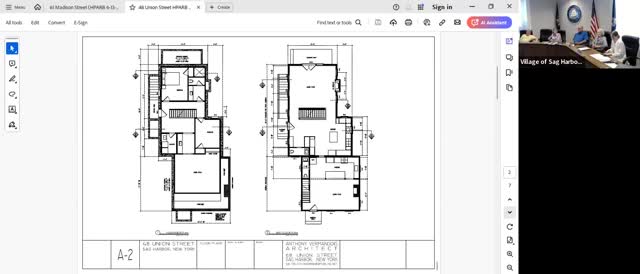Renovation plans spark debate over historic home aesthetics
July 15, 2024 | Sag Harbor, Suffolk County, New York

This article was created by AI summarizing key points discussed. AI makes mistakes, so for full details and context, please refer to the video of the full meeting. Please report any errors so we can fix them. Report an error »

In a recent government meeting, discussions centered around the restoration and renovation of a historic house, focusing on maintaining its original appearance while making necessary updates. The project aims to restore much of the house's original fabric, which has significantly diminished over time, with the front door and much of the trim already removed.
Key changes proposed include altering the window configuration on the dormer from two large windows to three smaller ones, and replacing the existing picture window with two six-over-six double-hung windows. The current steel door will be replaced with a historically appropriate design, and a new addition at the back of the house is planned, which will be longer but narrower than the existing structure.
Concerns were raised regarding the height of the new addition, with assurances that it will be ten inches lower than the main house's ridge, a change from the previously approved six inches. The rear elevation design features vertical boards, which sparked debate among board members about the aesthetic compatibility with the historic character of the house. Some members expressed a preference for horizontal boards, arguing that the vertical design clashed with the overall look and feel of the property.
Further discussions highlighted the number and size of windows on the new addition, with suggestions to reduce their scale and spacing to better align with the proportions of the original house. The board noted that the current design resembles a meeting house rather than a residential structure, prompting calls for simplification to enhance visual harmony.
Overall, while the restoration efforts were generally supported, board members emphasized the need for careful consideration of design elements to ensure that the renovations respect the historical integrity of the property. The meeting concluded with a consensus on the importance of balancing modern updates with the preservation of the house's original character.
Key changes proposed include altering the window configuration on the dormer from two large windows to three smaller ones, and replacing the existing picture window with two six-over-six double-hung windows. The current steel door will be replaced with a historically appropriate design, and a new addition at the back of the house is planned, which will be longer but narrower than the existing structure.
Concerns were raised regarding the height of the new addition, with assurances that it will be ten inches lower than the main house's ridge, a change from the previously approved six inches. The rear elevation design features vertical boards, which sparked debate among board members about the aesthetic compatibility with the historic character of the house. Some members expressed a preference for horizontal boards, arguing that the vertical design clashed with the overall look and feel of the property.
Further discussions highlighted the number and size of windows on the new addition, with suggestions to reduce their scale and spacing to better align with the proportions of the original house. The board noted that the current design resembles a meeting house rather than a residential structure, prompting calls for simplification to enhance visual harmony.
Overall, while the restoration efforts were generally supported, board members emphasized the need for careful consideration of design elements to ensure that the renovations respect the historical integrity of the property. The meeting concluded with a consensus on the importance of balancing modern updates with the preservation of the house's original character.
View full meeting
This article is based on a recent meeting—watch the full video and explore the complete transcript for deeper insights into the discussion.
View full meeting
